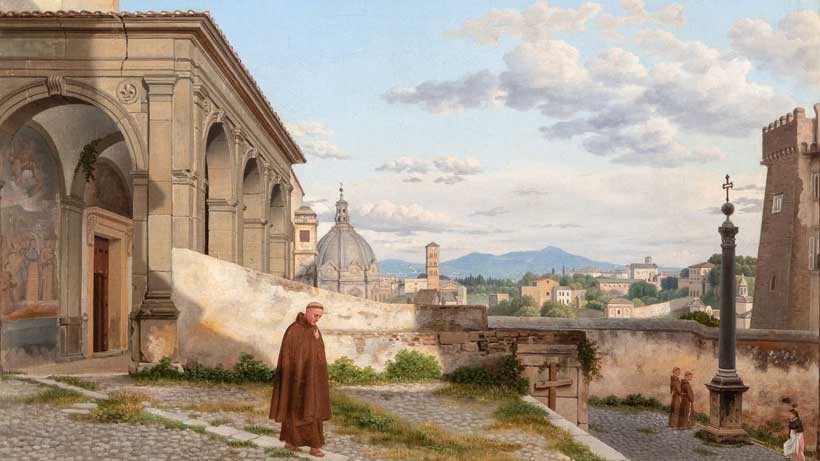“Eckersberg’s Roman city prospects are in great demand. It was here that he did his very first plein-air paintings and therefore it also marks the beginning of what we largely associate with and love about the Danish Golden Age. Plein-air painting is the practice of painting under the open sky, directly in front of the motif, unlike in the past, where the artist traditionally painted and completed his or her works in the studio,” explains Julie Arendse Voss, Head of Department and Specialist in Fine Art at Bruun Rasmussen.
In a letter to his friend and fellow painter I. P. Møller in 1815, an enthusiastic Eckersberg wrote: “… those were simply my happiest hours, when I ran out into the open air, a paint box and chair under my arm to paint nature.”
The painting up for auction depicts the view from the Capitol with the Alban Hills far off on the horizon. Eckersberg was able to stand here and paint in the shade. It is late afternoon and thus it is not the burning, harsh midday sun we see in the painting, but the milder, late afternoon light, which also sets this painting apart from several of Eckersberg’s other prospects.
“It is the light, the lines and the colours that are significant in this work, and the interaction between the density of the architecture and the open view over the city towards the hills. The figures were likely added later as picturesque window dressing,” says Julie Arendse Voss and continues: “Many of Eckersberg’s Rome prospects were started and completed on site, in front of the motif, while others were begun in front of the motif and completed in the studio.”
Epochal Travels and Innovation in Danish Art
Upon graduating from the Royal Danish Academy of Fine Arts in 1810, Eckersberg embarked on a lengthy study trip to Paris and Rome. After three years in France, he moved on to Rome in 1813, where he remained for three years. It was here that he began to paint his Rome prospects under the open sky.
Eckersberg’s travels were absolutely pivotal to his artistic development, and his cityscapes from Rome were an innovation in Danish art. Plein-air painting was later introduced as an integral part of the curriculum at the Royal Danish Academy of Fine Arts in Copenhagen – one of the first places in Europe to do so.
“All the works from his great, epochal journey are today extremely sought after by art collectors and museums worldwide, not least because they are so innovative and hard to come by,” says Julie Arendse Voss.
At Bruun Rasmussen, we are also seeing great interest among Danish and international museums. In 2011, Eckersberg’s Roman prospect “En anden Del af Via Sacra” (Another Section of the Via Sacra) was purchased by The Metropolitan Museum of Art in New York for DKK 3.4 million. In 2020, the masterpiece “Akvædukten i Arcueil” (The Arcueil Aqueduct) from 1812, which Eckersberg painted during his stay in Paris, also broke all previous records when it fetched a hammer price of DKK 5.6 million. It was bought by the David Collection in Copenhagen.
Demand for Rome Prospects
Eckersberg had many of his Roman prospects hanging in ‘the yellow living room’ of his professor’s residence at Charlottenborg, where his students could see them, study them and copy them. As studies and study objects, they were not of commercial interest and not, as such, in demand either. It was only later that the eyes of the world were opened to them.
“It’s funny to see how the demand for works by a given artist changes over time. In Eckersberg’s day, it was not his Roman prospects that were in demand, but his more elaborate works painted in the studio. Today, however, his Rome prospects are some of his most sought-after and most expensive works,” says Julie Arendse Voss.
The painting “Den nordøstlige side af Capitol” by C.W. Eckersberg is estimated at DKK 3–4 million and will go under the hammer at Bruun Rasmussen’s Live Auction in Lyngby on 4 March.
